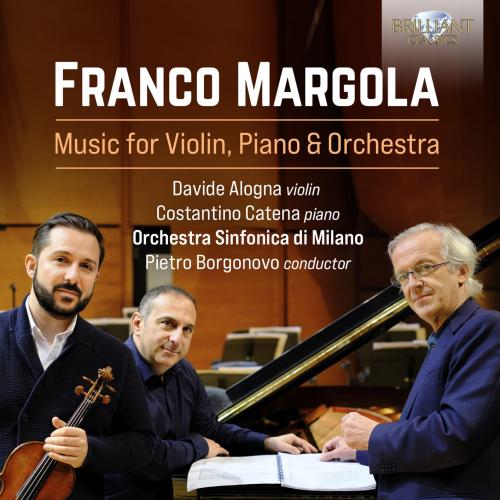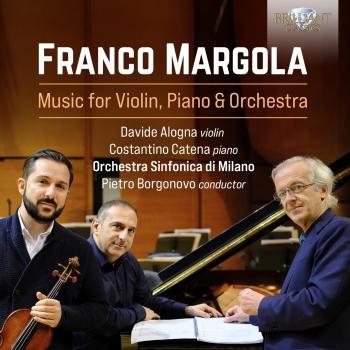
Margola: Music for Violin, Piano & Orchestra Davide Alogna, Costantino Catena, Orchestra Sinfonica di Milano & Pietro Borgonovo
Album info
Album-Release:
2022
HRA-Release:
02.11.2022
Label: Brilliant Classics
Genre: Classical
Subgenre: Concertos
Artist: Davide Alogna, Costantino Catena, Orchestra Sinfonica di Milano & Pietro Borgonovo
Composer: Franco Margola (1908-1992)
Album including Album cover
- Franco Margola (1908 - 1992): Concerto dell'alba, dC292:
- 1 Margola: Concerto dell'alba, dC292: I. Cantabile 05:18
- 2 Margola: Concerto dell'alba, dC292: II. Lento 02:38
- 3 Margola: Concerto dell'alba, dC292: III. Rondo 03:15
- Kinderkonzert No. 2, dC109:
- 4 Margola: Kinderkonzert No. 2, dC109: I. Allegro 05:51
- 5 Margola: Kinderkonzert No. 2, dC109: II. Sostenuto 04:27
- 6 Margola: Kinderkonzert No. 2, dC109: III. Allegro finale 04:55
- Sonata in D Major, dC12:
- 7 Margola: Sonata in D Major, dC12: I. Sostenuto, andante, poco sostenuto 09:23
- 8 Margola: Sonata in D Major, dC12: II. Lento 05:27
- 9 Margola: Sonata in D Major, dC12: III. Vivace 03:40
- Doppio concerto, dC132:
- 10 Margola: Doppio concerto, dC132: I. Allegro imperioso 07:56
- 11 Margola: Doppio concerto, dC132: II. Adagio 03:18
- 12 Margola: Doppio concerto, dC132: III. Allegro 09:16
- Variazioni sopra un tema giocoso, dC143:
- 13 Margola: Variazioni sopra un tema giocoso, dC143 16:07
Info for Margola: Music for Violin, Piano & Orchestra
Franco Margola (1908–1992) had an unwavering and authentic love for the violin, lasting throughout his career and artistic development. This recording showcases the versatility of the Brescian composer and the evolution of his musical thought over his lifetime. Often resisting the fashions of his time, the composer balanced tradition and modernism. In the aftermath of the Second World War, Margola became intolerant of harsh and violent sounds and so preferred writing more relaxing pieces.
Kinderkonzert No.2 is a work for violin and orchestra (1954). In the first movement, the writing is fluid and melodious. Only during the cadenza does the atmosphere become more serious, and the lightness that characterised the entire movement is only rediscovered with the return of the full orchestra. The next movement, Sostenuto, has a dreamlike character that comes to life in the central section with dance-style music. In the final Allegro, the soloist’s part is characterised by brilliant virtuosic writing which fits well into the articulated orchestral texture.
Almost thirty years later, Margola wrote Concerto dell’alba for violin and string orchestra (1982). Intended to be the third of the Kinderkonzert, Concerto dell’alba sounds free from any form of modernism and cerebralism. Nevertheless, the composer uses a modern idiom with wisdom and discretion which creates a spontaneous musical eloquence and cantabile sound. A vigorous RondoÌ with lively popular tunes concludes the Concerto.
The composer proposed a decidedly neoclassical writing style in Variazioni sopra un tema giocoso (1965), placing well calibrated sounds within a formal structure. Also neoclassical, Sonata in D (1931) is the first of a series of five violin sonatas and reveals the composer’s technical mastery. In the first movement, two themes are alternated: one serious, and the other dreamy, seemingly floating on the arpeggiated piano accompaniment.
In 1960, the Doppio concerto for violin, piano and string orchestra was published. Once again, Margola refused to follow contemporary musical fashions, instead following his own nature in the search for an expressive and spontaneous language. The three tempos that make up the Doppio concerto follow each other seamlessly and show us a cleverly devised composition where the romantic musical idiom is updated in the light of the experiences of the new century.
Franco Margola (1908-1992) has his musical roots in the 19th century, in particular in the cultural movement which was predominantly interested in instrumental music, as opposed to the opera. Franco’s musical language is classicist, with clear formal structures and a leading role for the melody.
Following the success of the piano Kinderkonzert, which was played by the legendary Arturo Benedetti Michelangeli, Franco Margola composed, after almost thirty years, to two similar works for the violin: the Kinderkonzert no. 2 for violin and orchestra and the Concerto dell'alba for violin and string orchestra, works of intimate charm, fluidity and cantabile. Also included are the Variazioni sopra un tema giocoso for string orchestra, a Sonata for violin and Piano and the highly attractive Double Concerto for Violin, Piano and String Orchestra.
Beautifully played by Davide Alogna, one of Italy’s best known violinists. Alogna was soloist with conductors like Riccardo Muti, Eliahu Inbal, and Zubin Mehta. The pianist is Costantino Catena, a strong advocate of Italian piano music, particularly by Ermanno Wolf Ferrari. They are accompanied by the excellent Orchestra Sinfonica di Milano, conducted by Pietro Borgonovo.
Davide Alogna, violin
Costantino Catena, piano
Orchestra Sinfonica di Milano
Pietro Borgonovo, direction
Please Note: We offer this album in its native sampling rate of 48 kHz, 24-bit. The provided 96 kHz version was up-sampled and offers no audible value!
Davide Alogna
has eclectic and international music education.
He graduated both in violin and piano with honour at Conservatorio “G. Verdi” in Como and he obtain his master diploma in solist violin and chambre music at the Conservatoire Superieur Paris with a “Premier Prix a l’Unanimitè”.
He also studied composition and graduated with a special mention at Accademia Chigiana of Siena with Giuliano Carmignola that describes him as “an amazing talent”.
In 2017, Davide was invited by La Scala Orchestra to play concerts as guest soloist in Europe and on the 29th of October debuted at the Teatro Alla Scala of Milan with the La Scala Chamber Orchestra.
Davide has already debuted in many important halls such as Carnegie Hall (Stern Hall), Teatro alla Scala, Berliner Philarmonie, Suntory Hall of Tokyo, Smetana Hall of Prague, Grand Theatre of Shangai, Salle Cortot of Paris, Gasteig and Herkulesalle in Germany, Palacio de Bellas Artes in Mexico City, Mahidol Hall of Bangkok and the Verdi Auditorium of Milan.
He has been accompanied by some of the world’s leading orchestras, including La Scala Chamber Orchestra, Arturo Toscanini Philarmonic, Orchestra da Camera di Mantova, Orchestra Filarmonica Italiana, Sanremo Symphony, Thailand Philarmonic Orchestra, Munich Kammerphilharmonie, Tchaikovsky Philarmonic, Northern Czech Philharmonic, Chamber Orchestra of New York, New England Symphony, Mexico State Symphony Orchestra, Bellas Arte Chamber Orchestra, Monterrey Symphony, Istanbul Philarmonic, Adana State Symphony Orchestra, Kalisz Philharmonic and the Lutowslasky Filarmonic Orchestra, alongside great soloists and conductors including Natalia Gutman, Eliso Virsaladze, Bruno Canino, Roberto Prosseda, Roberto Plano, Lior Shambadal, Dariusz Mikulski, Giulio Tampalini, Hakan Sensoy and Francesco Lanzillotta.
His solo career began in 2009 with the Prix d’Interprétation Musicale de la Citè Universitaire de Paris, and in 2010 he was awarded the Excellence Prize in Music in Milan.
In 2009 he has given a Stradivari for different exhibitions for RAI 1, for the Council of Ministers, and a tournée with Brahms Sonatas in U.S.A.
On May 2019 has released his debut album for Warner Classics.
Davide has recorded for different labels including Naxos, Brilliant Classics, Amadeus, Velut Luna, Phoenix Classics. His recordings have aired on radio stations such as RAI Radio 3, Radio Classica, Swiss Italian Radio, Venice Classical and Radio France. Amadeus Magazine chose Davide twice as “Artist of the Month” and published articles on his recordings of Schubert violin sonatas and Respighi’s violin concertos. In September 2016 Davide released a CD of music for violin and piano with the pianist Bruno Canino for the national magazine Suonare News.
In 2018 he recorded for Naxos a CD with 3 “world premiere” of Mario Castelnuovo Tedesco violin works as the 3rd Concerto for violin and piano dedicated to Jascha Heifetz that received 5 stars from many international musical magazine as “Musica” and BBC Magazine.
Davide Alogna is Professor of Violin at the ‘F. Cilea’ Conservatory of Music in Reggio Calabria (Italy).
He performs on his precious Giuseppe Fiorini violin (Munchen, 1906) and Carlo Antonio Testore /Ex Wilhelmj violin (Milan, 1715).
This album contains no booklet.













